
The Retrogaming Times
- The Bimonthly Retrogaming Hobbyist
Newsletter -

The Retrogaming Times
- The Bimonthly Retrogaming Hobbyist
Newsletter -
|
The run up to May is always a frenzied time for me. While it would be more on topic to say it has to do with video gaming of some sort, my crunch around this time of year has to do with a large anime and Japanese culture convention my wife and I have attended for nearly a decade. Although the convention takes place at the end of May, preparation becomes an especially large focus from the beginning of April onward. Even though this lends itself to less free time spent playing video games, they still provide a welcome break now and then. Essentially relaxing from one hobby by investing time back into another, if you would. Our commitment to publishing a diverse and hobbyist driven retrogaming newsletter continues regardless.
We begin as usual with More C64!, this time Merman reviews a pair of new Commodore 64 adventure games designed in the vein of Metroid. Classic gaming and a modern trade event cross paths in a special piece from Donald Lee. When Nintendo released the Virtual Boy they began the era of 3D simulated depth gaming in the home. A gaming system where the controller couldn't be seen during gameplay created some new challenges and Todd Friedman looks at the limited days of the platform in The Controller Chronicles. Arcade Obscure returns with Blood Bros., the unique arcade-only sequel to the popular action shooter Cabal. Ninjas invade the Sega Master System as Mateus Fedozzi continues reflecting on his memories of the platform in Brazil. New contributor Sean Robinson muses about the recently announced continuation of the Sakura Wars franchise and looks back upon a modern retro series that is barely known outside of Japan. With so many Famicom games left unreleased on the NES, there are some interesting titles gamers outside of Japan missed out on. Jumpin' Kid is one such game and it is featured in a new column, Forgotten Famicom. All that and more are ahead in this issue of The Retrogaming Times.
I want to again remind our readers if they
have comments or questions about anything covered in the newsletter, or
there is something they would like featured in a future issue of The Retrogaming
Times, to let us know via The Retrogaming Times on Facebook at facebook.com/theretrogamingtimes
or contact me directly at trt@classicplastic.net!
Of course submissions are also always open. If you have something
ready to go, the address is the same, trt@classicplastic.net. "If
there is something you want to write about, send it in!"
|
Pintastic Pinball & Game Room Expo, June 28th - 20th 2018, Sturbridge, Massachusetts, USA
Do you love pinball? Are you looking for a little relief from the hot summer sun? Look no further than Pintastic New England, which is the first of its kind, centrally located in Sturbridge, Massachusetts. This expo is 30,000 square feet of fun for the whole family. The kids can have never-ending excitement with a caricature artist, face painting, friendly clowns, balloon animals, yo yo and juggling show. The adults can bring out their inner child with over 200 pinball machines set on free play, all while enjoying an ice-cold craft beer.
For more information, visit https://pintasticnewengland.com/
~ ~ ~
Video Game Summit, July 14th 2018, Villa Park, Illinois, USA
Remember how much fun you used to have playing Atari, Nintendo and all kinds of games on your computer? Well, you will have the rare opportunity to play these great games again at the Video Game Summit, Chicago's premier video game trade show.
The Video Game Summit, now in its 15th year, brings together classic and modern generation gamers from all over the country to swap stories and games. Best of all, admission to The 2018 Video Game Summit is only $10.00 per person (kids 12 and under with adult is free). We will have Early Admission this year again due to positive response from last year.
The Video Game Summit is being held on July 14th, 2018 from 10 am until 6 pm at The Odeum Expo Center, 1033 North Villa Ave., Villa Park, Illinois.
For information on the show visit us at: http://www.VideoGameSummit.net
~ ~ ~
KansasFest, July 17th - 22nd 2018, Kansas City, Missouri, USA
KansasFest is the world's only annual convention dedicated to the Apple II computer that revolutionized the personal computing industry. Held every year in Kansas City, Missouri, KansasFest offers Apple II users and retrocomputing enthusiasts the opportunity to engage in beginner and technical sessions, programming contests, exhibition halls, game tournaments, and camaraderie. Any and all Apple II users, fans, and friends are invited to attend this year's event.
This year marks the 30th time that this event has been held. In July 1989, Resource Central held the first A2-Central Developer Conference, focused on the individuals and companies who were still producing hardware and software for the Apple II and IIGS computers. Within a couple of years, the event transformed into a conference for Apple II developers and users alike.
This year, KansasFest welcomes back one of its alumni, Roger Wagner. Though 2018 will mark Wagner's third time as a keynote speaker for the event, most current attendees haven't had the opportunity to hear him speak because his last appearance was 23 years ago. He has deep roots in the Apple II community, back to the beginnings of the platform.
For more information, visit http://www.kansasfest.org/
~ ~ ~
ReplayFX, July 26th - 29th 2018, Pittsburgh, Pennsylvania, USA
Gamers behind the Replay Foundation & PAPA are taking over the David L. Lawrence Convention Center and filling it with more than 1,000 full-sized modern and classic arcade and pinball machines, over 2,000 retro console games playable on more than 250 console gaming stations dating from the 1970’s right up to the newest consoles like the XBox One, Nintendo Switch, and PS4, an entire section with dozens of tables dedicated to tabletop and board games, a showcase of new products by game developers, magicians, live musicians, balloon artists, face-painters, competitions offering over $110,000 in prize money, and more!
The Replay FX Arcade & Video Game Festival will feature the largest public collection of working pinball, arcade, tabletop, and console games anywhere in the solar system, and all games are free to play with the price of admission! Attendees are also invited to attend a series of seminars dedicated to gaming and its associated tech-culture, browse merchandise in the marketplace, watch the world's greatest pinball wizards compete in the Pinburgh Match-Play Championship, or enjoy a series of fun and wacky daily challenges at no additional cost!
Replay FX will include multiple live musical performances, a high-energy cosplay contest, inflatable obstacle courses, and more in a show floor packed with over a quarter-million square feet of entertainment! Over $110,000 will be at stake for the competitive player. Thousands of games will be available for the casual fan. A family-friendly atmosphere will be available for the kids, and no one has to leave the galaxy to attend!
For more information, visit https://replayfx.org/
~ ~ ~
California Extreme 2018, July 28th - 29th 2018, Santa Clara, California, USA
California Extreme is pleased to announce July 28-29, 2018 as our official dates for the 2018 California Extreme Arcade and Pinball Show. It will be held at the same fantastic location - the Hyatt Regency in Santa Clara, California. Please join us for our 22nd show with hundreds of your favorite arcade and pinball games, both past and present, all gathered together for another fun-filled weekend of pure arcade excitement for folks of all ages!
We are working on this year’s lineup of seminars, guest speakers, and other arcade-themed events that make the show so much fun each year. Pre-registration is currently open!
Start making your plans, requesting time off work, making reservations by planes, trains, automobiles, and especially trucks to come out and join us for another crazy, arcade-filled weekend!
For more information, visit http://www.caextreme.org/
~ ~ ~
Retropalooza, September 29th - 30th 2018, Arlington, Texas, USA
A celebration of all things retro! Retropalooza was started in 2013 in Arlington, Texas by a couple of guys who enjoy all things retro; from toys to music, to video games... especially video games. As video game collectors, they spent a lot of time and money looking for retro games when they figured it would be easier to bring the games to them. Thus, Retropalooza was born.
The goal of Retropalooza is to bring nerds from all walks of life together for an enjoyable, family friendly time. Good old fashioned fun with like minded people where it will always be affordable, and forever improving.
For more information, visit http://retropalooza.com/
~ ~ ~
If there is a show or event you would
like listed here, free of charge, please contact David directly at trt@classicplastic.net.
Please include a short official blurb about your event along with any relevant
links or contact information and it will be published in the next issue
of The Retrogaming Times. The event listing will remain posted until
the issue following the event date. Big or small, we want to promote
your show in our newsletter. Check out these great events, shows,
and conventions and let them know you read about them in The Retrogaming
Times!
|
Two recent releases from Psytronik have arrived, and they both use the Metroid template to create memorable action adventures. They come from two different people and have completely different settings, but both are worth playing. Here's what I made of them.
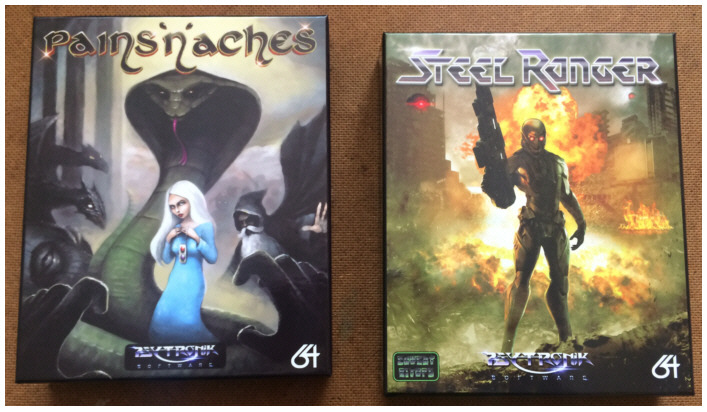
STEEL RANGER
Coding & Design by Lasse Öörni
Graphics by Lasse Öörni
Music by Lasse Öörni
Packaging Artwork by Trevor Storey
Lasse is no stranger to the C64, having previously published the brilliant Metal Warrior games and 2016's release Hessian. All feature a similar run-and-gun style, the player having to talk to NPCs (Non-Player Characters) to advance the plot and plenty of weapons. This latest release is even more ambitious.
In the year 2218, Earth is under threat from a hostile machine intelligence. It has stolen supplies and created a devastating fleet. The patrol ship Scourge, commanded by Archer Hess, receives a strange symbol - Omega, coded in ones and zeroes. Is this the end of humanity? The ship travels down to the transmission's source and comes under attack. Archer puts on his Ranger suit and investigates.
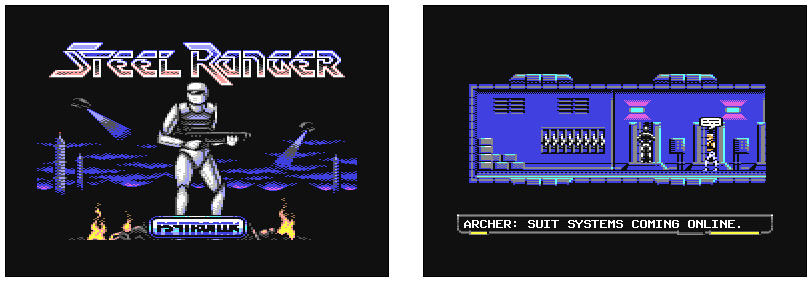
The Steel Ranger loading
screen, and putting on the Ranger suit.
Initially the player has a simple weapon (Full Auto, which requires extra bullets to be collected regularly to maintain automatic fire). By killing enemies extra ammunition, parts and energy upgrades can be obtained. New weapon types will also be found, switched by pressing the number keys. Key cards are needed to pass certain barriers, opening up more of the machine city. And because the machine's technology is compatible with the suit, it can be upgraded. Parts can be spent to buy more ammunition, energy chambers recharge the suit's power and key terminals will add features to the suit. The first to be found is Wheel Mode, similar to the Morph Ball in the Metroid games. This allows the player to roll through small gaps and drop mines.
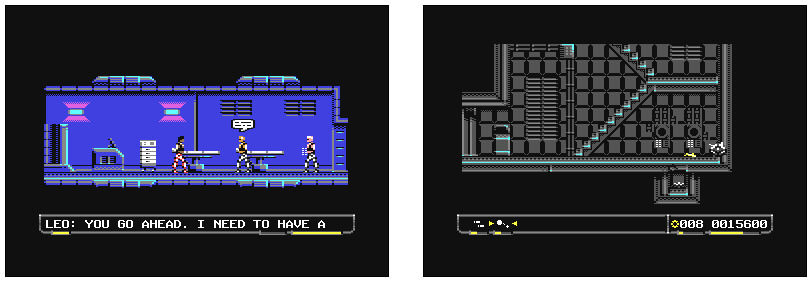
Talking to NPCs, and
dropping a mine in Wheel Mode.
Pausing the game reveals the current status and a helpful map, which can be "panned" to show where the player has to go. Radio messages from the ship's crew and interactions with terminals will reveal more of the story, unlock new areas and allow the player to progress. Lifts are incredibly important, and can be called to the current level by activating the terminals. Every now and then a Guardian will be unleashed, with its awesome firepower testing the player's skills. The name and appearance of the hero can be changed on the title screen. There are also four save slots on the game disk, allowing the player to save their progress. Dying will reset the player to the nearest entrance they used, effectively a "continue."
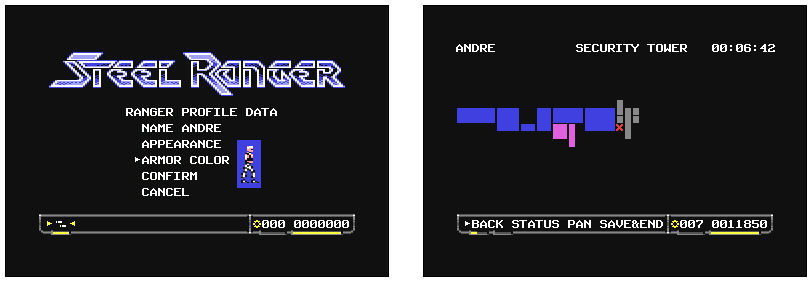
Customising your hero,
and checking out the map.
The graphics throughout are impressive, creating a huge world with a consistent look and feel. There are distinctive sections, with the dark caves giving way to the metallic city. The main player sprite is very athletic, and the Wheel Mode is such a neat addition. There is a real feeling of exploration, and a genuine sense of achievement as you unlock new areas. There is top-notch music and sound FX accompanying the action, although the latter are quite sparse. Lasse has built a bigger and better game than Hessian, and continues to be a C64 coding star.
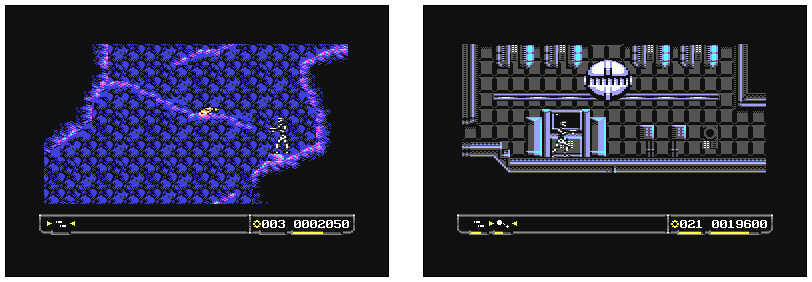
Exploring a cave, and
fighting the first Guardian.
Steel Ranger is available in multiple forms.
A digital download is available from https://psytronik.itch.io/steelranger
Physical copies are available from http://www.binaryzone.org/retrostore/
There are three options, and each will also include the digital download:
PAINS 'N ACHES - A KNIGHT 'N GRAIL ADVENTURE
Coding & graphics by Mikael Tillander
Additional graphics by Håkon Repstad
Music & SFX by Hans Axelsson
Game artwork by Håkon Repstad
From the team that brought us Knight 'n Grail, this new game continues the fantasy adventure with a whole new story. The Knight gave the Grail to the Archmage for his help, but now the Archmage's partner has been turned into a hideous beast by the magic of the Titans. The Archmage must take human form and seek out the magic pendant that will remove the spell from his partner.
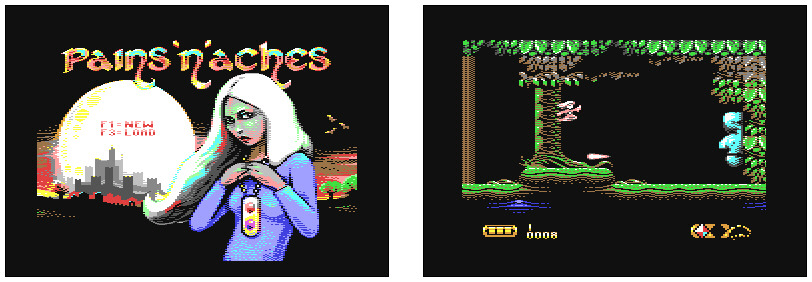
The title screen of Pains
'n Aches, and fighting the first boss.
Loading the game gives the choice of starting a new game or loading the saved game. There is only one save per disk image. After collecting the pendant and the first red crystal, the Archmage can shoot magic at the many enemies that fill the levels. Pausing gives access to a helpful map and the inventory screen. The game can be saved at certain Stones, while others are read to give clues. The coloured crystals can be combined, as there are two slots in the pendant. Each colour crystal will unlock the same coloured door by shooting it. Killed enemies and treasure chests will drop coins and gems that are used to buy extras and hints. There are also destructible blocks in the scenery that can be shot to reveal bonuses. Certain characters will send the player on quests; for example, the Hunter requires you to find his stolen arrows and return them to him. Much like Metroid, new magical powers will allow you to access previously blocked areas. These include a double jump and a "dash" move to fly over obstacles.
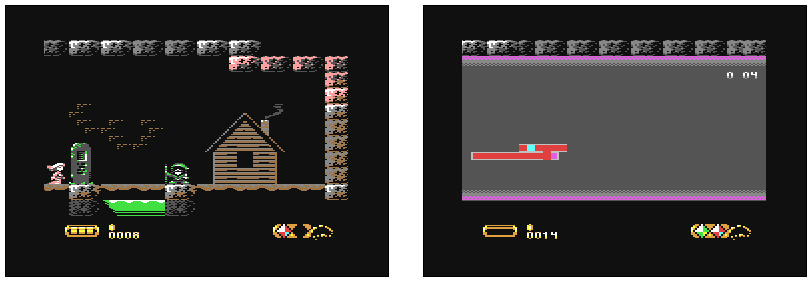
Getting help from a stranger,
and checking the map.
The fantasy setting may be very different from Steel Ranger, but the two games share a similar structure and a high degree of polish. Pains 'n Aches is very well made, with some great graphics - especially the background details. Music and sound are suitably atmospheric. Control is at times a little tricky to get used to, but a recent patch has removed a bug where the player could get stuck in the scenery. It's a shame there is only one save slot and there are regular pauses in the action to load new sections. The end result is a massive map to explore and some interesting puzzles to overcome. Just like Steel Ranger, there is a lot of depth and playability here.
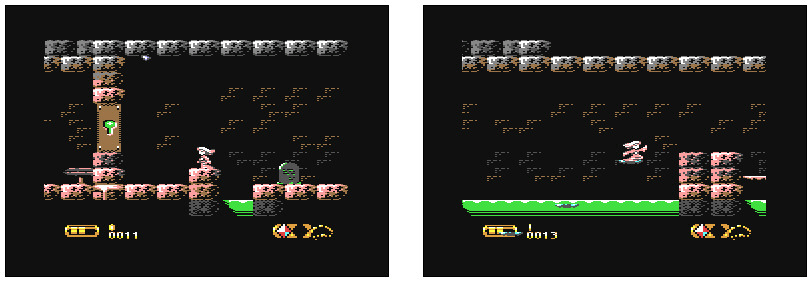
What's behind the green
door, and can the Archmage get past the falling platforms?
Pains 'n Aches is available in multiple forms.
A digital download is available from https://psytronik.itch.io/painsnaches
Physical copies are available from http://www.binaryzone.org/retrostore/
There are three options, and each will also include the digital download:
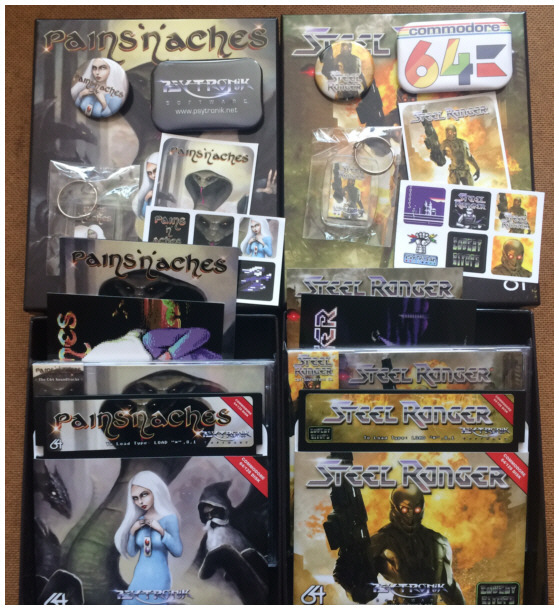
NOTE: The author of this article
paid for his versions of the games.
|
Hello and welcome to the May 2018 issue of The Retrogaming Times. Its been a long last couple of months since I last wrote. Thanks to an award I had won, I was in Hawaii in the early part of March. Since I came back, I feel like I've been going non-stop with very little breaks.
I was actually struggling to think about what to write this month until I realized I had the perfect topic staring me in the face this week. This entire week, I am working at the Moscone Center in San Francisco. My company has a booth at the RSA Conference. The conference focused on Internet security and other technology and draws a ton of visitors every year. This will be my 3rd or 4th consecutive year working the conference booth for my company. Last year, our booth had space for us to host small speaking engagements. I was fortunate to host two short speaking engagements, which was fun. But the booth was sparse and sometimes didn't attract of a lot of attention.
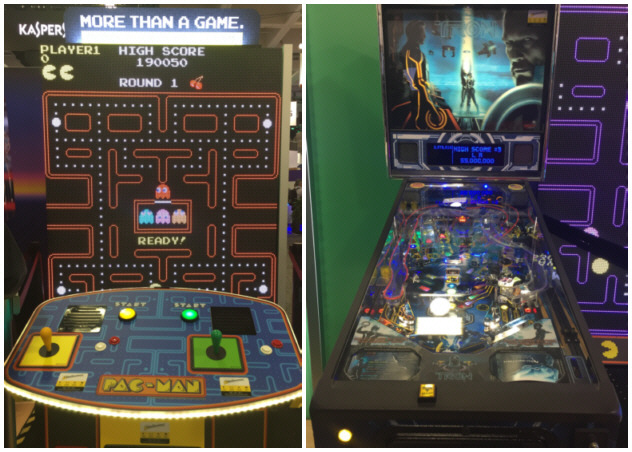
This year, the powers that be decided to make our booth more engaging and fun. So on side of the booth we had a big Pac-Man machine that could be played solo or have two players play at the same time. Right next to the Pac-Man machine, we had a Tron pinball machine. The pinball game is HARD and something happened to the machine where the balls get stuck and we have to tilt the machine to get the balls loose.
Then lastly, on the other side of the booth where my co-workers and I engage people in discussion, there was an Atari 2600 / VCS flashback console which was connected to a TV and had Missile Command. Missile Command was selected because of some of the services my company offers. But even as a retrogaming fan, I didn't think it was all that exciting (especially the 2600 version) to try to get people interested in our services. So one of the big shots in our company had the Atari 2600 Flashback console disconnected and replaced with a visual display of one of my company's services.
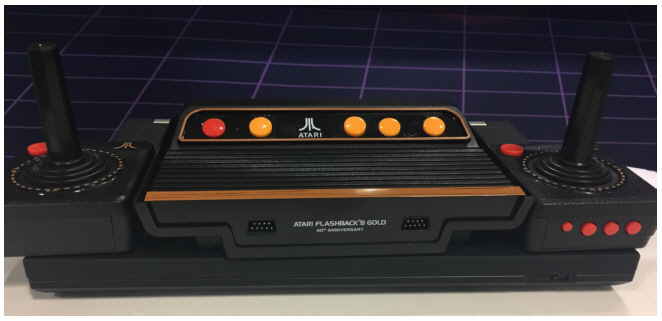
So while the Atari 2600 Flashback console / Missile Command didn't garner much interest, the Pac-Man and Pinball machines have garnered a lot of people's interest. As a retrogaming fan, I'm happy people saw the games and played them. While talking business to some folks, I even gave a shoutout to the High Scores Arcades and Pacific Pinball Museum in the Bay Area.
If you were to ask my company's booth organizer, I'd think she would agree the games were a success draw. Now from a business perspective, hopefully the visitors end up becoming customers. That's ultimately why my company had a booth. I thought this was worth mentioning to our readers here. Retrogaming is definitely around and thanks to my company, we shared with a lot of people who may not have been aware of it.
See you next issue!
|
The Virtual Boy is a video game system developed by Nintendo and released in 1995. It consisted of a red box on black legs with a black visor which players would look into for game play. Virtual Boy game images are 3D and are displayed using mirror-scanning technology. They appear on LEDs in four shades of red with a black background. The image is reflected off of oscillating mirrors, which create the apparent thickness of the image. This type of graphics was once referred to by Nintendo as "true 3D." Digital stereo sound is emitted from the self-contained speaker system found on either side of the visor.
The Virtual Boy's controller features two D-pads on opposite ends implemented for the player to play along a Z axis. This is the only Nintendo controller that features two D-pads. Aside the D-pads, there are four buttons, a gray Start button and Select button, and an A button and B button, both red. The controller is also the power source for the system itself via a battery pack on the back of the controller. In more traditional two-dimensional games, the two directional pads are interchangeable. The symmetry of the controller also allows left-handed gamers to reverse the controls.
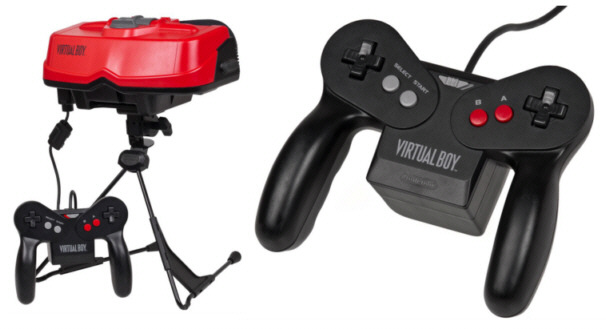
Given the system's short lifespan, only 22 games were released for the Virtual Boy. These are some of the most popular ones and ones that I still play today. We will talk about these titles that made 3-D gaming fun and how the controller worked on these titles. Mario Tennis, Golf and 3D Tetris.
Mario's Tennis is a sports game in which the player controls one of seven different Mario characters and engages in tennis matches. Mario's Tennis supports a number of different game modes and customization options. The player may choose one of seven Mario characters, including Mario, Luigi, Princess Toadstool, Yoshi, Toad, and Donkey Kong Jr. To move the player, you will use the left direction pad on the controller. When serving you can move the player left or right. Press either A or B to toss the ball in the air. Hitting A or B again will serve the ball. Timing is key on this depending on where you want to the ball to land and making sure it gets over the net. Depending on where the ball is on the return and the volleys, hitting the A button will give a normal hit. If the ball is over your head, you will automatically do an overhead smash. If you hit the B Button instead you will so a lob shot over the net. The key to directing the ball comes into play with the directional pad. Up will make a long back court shot, down will hit a short front court shot. Left or right will hot the ball towards the sidelines. This game looks and feels great for the era it came out.
Golf is a golf video game that was released within months of the Virtual Boy console's launch. The game uses standard golf rules and is set in the fictional 18-hole Papillion Golf & Country Club. Hazards include water, sand traps, trees, and deep rough grass. Players can choose their club and various aspects of the club's swing, including speed, direction, stance, swing power, and the ball impact point. Swing power requires players to stop an indicator at the right moment on a vertical arrow; the ball impact point requires players to stop a zig-zagging indicator as it moves down and then up on a close-up of the ball. If players allow the indicator to move all the way up the vertical arrow, they will be given another chance to time their shot; if they allow the zig-zagging indicator to reach the top, the game will automatically stop it at the very top. Players can also place a grid on a nearby portion of the course to aide with the aim and distance of their shots. Players can choose between five different viewing perspectives, change button configurations, and review the positives and negatives of their last shots.

Mario's Tennis (left),
Golf (center), 3D Tetris (right)
3D Tetris allows players to control multiple falling blocks, rotating and positioning them to clear layers in a well. The game is similar to other Tetris games, but uses a three-dimensional playing field as opposed to the traditional two-dimensional view. The game contains multiple modes and game types, as well as different difficulty settings and levels, which change different aspects of the gameplay. The left control pad moves the block in its horizontal plane as it falls. The right control pad makes the blocks drop faster when wanting to sleep up the action. The A button will rotate the blocks clockwise as you need them to fill the spaces and complete the lines. The B button will rotate the blocks counter clockwise to make the adjustment faster when needed. Playing Tetris in 3D back in the 90s really made the game more interesting and exciting. Tetris has been on virtually every device known to man, but this version stands out as being unique with the 3D addition and the music and sounds that come with it.
The Virtual Boy is best known one of Nintendo's
worst failures and Gunpei Yokoi's last product during his working efforts
at Nintendo. But in my opinion, it still holds value today and entertainment.
Playing on a 3DS in 3-D is very bad on the eyes and gives me a headache.
I would prefer playing on the old school Virtual Boy and wish they had
more games created for it.
|
When I was nine-years-old my immediate family moved from Silicon Valley to California's central valley, about a hundred miles away. The arcades, bowling alleys and pizza parlors in this area exposed me to some of the more eclectic arcade games of the 1990's. While arcade games were still everywhere, they generally weren't the rows of old classics that had taken up residence in the South Bay Area for half a decade. Occasional mainstream shooters and beat 'em ups could be found, but most of the arcade games I encountered in the central valley were of the more oddball variety. My otherwise unexplainable love for games like DJ Boy and Sly Spy came from exposure to them during this time, as did my continuing regard for a fixed-perspective shooter called Blood Bros.
Developed by TAD Corporation and released in 1990, Blood Bros. (or Blood Brothers as is displayed on the cabinet artwork) is a follow-up to their 1988 arcade game Cabal. While Cabal had the standard military commando backdrop that was popular at the time, Blood Bros. is set in a somewhat over-the-top rendition of the American Old West. Two blood brothers, a cowboy and an indian, are on the trail of Big Bad John and his gang. How do they plan on taking him down? With a ton of lead and a handful of explosives - naturally. Each stage is presented as a single fixed environment, viewed from behind the player characters who run along the bottom of the screen. For those not familiar with Blood Bros. or Cabal, think of the corridor areas from the original Contra to understand how the perspective works.

The blood brothers level
an enemy town (left), there's always so much going on (center), a locomotive
serves as the first boss (right)
An eight way joystick positions an ever-present and color coordinated crosshair anywhere on the screen, used for aiming your character's weapons. Additionally each player has three buttons: fire, roll, and dynamite. If the joystick is moved without a button being pressed, it will also move your character to the left or right in the direction it is held. Pressing or holding down the fire button will cause your character to remain stationary and pivot around, firing an unlimited spray of bullets aimed where the crosshair is positioned. The roll button will cause your character to jump and roll in the direction of joystick movement, evading enemy fire in the process. It is also useful for quickly repositioning yourself in a different area or picking up bonuses. The dynamite button will make your character throw a stick of dynamite aimed where the crosshair is positioned, which will explode on impact. This replaces the function of a hand grenade in games with a more contemporary setting. Dynamite also has more destructive power than regular shots and can often eliminate more enemies due to its larger impact radius. Using the three buttons and joystick movement in combination allows quick evasion and weaving through enemy shots while providing precise shooting control.
In addition to enemy personnel and vehicles, nearly everything on the screen can be shot or blown to pieces. This includes objects on the ground, barriers, natural terrain, even full buildings. Each screen is accompanied by a "FOE" meter that serves as an enemy gauge, depleting as enemies are eliminated and key structures are brought to the ground. Draining the foe meter will complete a stage. Additionally there are often bonus items or humorous scenes that can be uncovered by destroying larger structures. In a nod to classic shooting gallery games, shooting these humorous characters will cause them to drop bonus items. Sometimes these are simply point increases that can be collected by running over them. Additionally extra dynamite ammunition can be collected in this manner. Weapon powerups can also be uncovered by shooting the terrain or special characters, these are a medium shotgun and a big rifle. Both increase the size of the target crosshair and boost weapon power, the rifle being the most powerful, but only they remain active for a limited time. Shooting wild boars that run across the screen is generally the most common way to generate a weapon powerup.

A good variety of environments
are featured (left), diving for cover (center), the pretty awesome title
screen (right)
Everything in Blood Bros. is colorful, detailed, and fluid - it really is one of the nicest looking games of its time. The amount of smooth animation and the breakneck pace in which the game moves creates a frantic and fun shooter that feels unlike anything else. Some of the areas get close to requiring the precision of a bullet-hell vertical shooter to evade enemy gunfire. As this is an arcade game it makes sense that the players would be pressed for another credit like this, but Blood Bros. never seems to forcibly place the player in an entirely impossible situation. While there is Western style music throughout the game, it is reasonably subdued behind the sound of gunfire and other sound effects. I do love the little title screen tune however, regardless of how short it is. Looking back, I'm glad the music takes a back seat to the sound effects, as otherwise they would be clashing against one another constantly.
My fondest memories of playing Blood Bros.
in the arcade occurred at a local bowling alley when I was ten or eleven.
Some of the teens there that night had rigged the coin switch with a string
device to register 99 credits. After awhile they dispersed and left
the machine with over 80 credits sitting on it, so myself and another kid
my age stepped up to the machine and proceeded to play though the game.
With no quarters on the line, I was able to relax and really enjoy the
game's over-the-top aesthetic. Strangely enough after that weekend
I never saw the game again, it had been moved out and replaced. Unfortunately
Blood Bros. never had a home release, although a Super Famicom conversion
has been said to have been in development at one time. Sadly, TAD
Corporation folded in early 1993 and the unique hybrid of a shooter and
a run-and-gun that they created was never further advanced. As it
stands, Blood Bros. is an outstanding and brisk action game that is even
more awesome when played with a friend. While it isn't something
I'd play every day, running through this game a few times a year is an
extremely satisfying experience.
|
It's possible to divide the Sega Master System history in two halves: the Japanese-centric 80's and the Euro-centric 90's. The first brought us Sega arcade ports, Japanese computer adaptations, and some original franchises, like Alex Kidd and Phantasy Star. The second was mainly comprised of Sega Genesis/Mega Drive ports and lots of licensed games, such as Astérix and the Disney games (it's interesting to notice, though, that many of the PAL exclusives were made by Sega themselves, back in the Land of the Rising Sun).
Since my SMS collection really started when my father bought ten used carts from a rental shop in 1998 or 1999, it's easy to deduce these ten games were examples of the second phase of the Master System library. Then came the games bought brand new, complete in box, by my mother, my brother, and finally by myself - first on the department stores like Americanas and Wal-Mart, later through the internet (Mercado Livre, the Brazilian version of ebay).
The Internet also revealed Tec Toy, the publisher responsible for the Sega games in South America, had skipped a lot of the first phase releases. There's no Brazilian Space Harrier or Brazilian Fantasy Zone, for example. Since the console was released here in 1989, four years after the Japanese release, it's easy to understand the lack of such classics on Tec Toy's library. Fortunately, Shinobi - one of my favorites - made the cut.

Shinobi is not only a very faithful rendition of the arcade classic, but also an excellent SMS action game by itself, with responsive controls, nice use of the color palette, a theme song that sticks in your mind, high difficulty and the most unnerving / unforgettable / tragically comic / maddening ending in history: a plain Game Over screen.

Speaking of ninjas, there was a surprise among my father's initial batch of ten used games. A game I had not heard of until then that captured my heart forever. Ninja Gaiden, a Sega-made sequel to the NES trilogy released only in Europe and South America. Made by the same guys who did the superb Master of Darkness, Ninja Gaiden is one of those late platform SMS games that, not unlike the late NES platform releases, stretch the limits of the console. Unfortunately, it has a major bug, which grants you an unlimited supply of the special powers if you're able to make the power's energy counter reach 999.

Besides the ninja games, there was a third game that impressed my younger self among those pioneering carts. It was a licensed game and it would become the first game I ever beat (it's a very easy game). The game was Taz-Mania, which Sega released alongside the Genesis / Mega Drive and Game Gear versions. The SMS version is the best by a long shot. It's the only version made in Japan, not in America, but it's the only version that shows deep respect for the Robert McKimson style of Looney Tunes animation. The game amazingly looks like a cartoon from the 1950’s (although it doesn't sound like one). It's also very playable and very enjoyable, aside from some sensitive jumping controls.
With the passing of the years, I would keep returning to my favorite gaming machine, time after time. Then came emulation and the fan websites (the Master System one I recommend is SMS Power!), and the age of discovering new gems by oneself was sadly over. Even so, the homebrew community is starting to get off the ground and I believe we aren't far from the day when we'll be accessing digital stores to buy new physical releases of Master System games. It already happened to the Atari 2600 and the Sega Genesis / Mega Drive, so why not to the Sega 8-bit wonder?
ERRATA: if you've been following
my articles, you may have noticed I mentioned having received my SMS in
1995 on my first article, and in 1996 on my second article. The latter
is the correct, 1996 was the year. Memories can be tricky and I apologize
for the mistake.
|
At SEGA Fes 2018, SEGA's company-sponsored festival held in Japan during the weekend of April 14th, a new Sakura Wars (Sakura Taisen) game was announced. This was further echoed on Twitter by the company and those involved. However, right now not much information has been shared about the game. Thankfully, we have some data with which we can extrapolate some specific, likely information. However, keep in mind that this data is being surmised and therefore, though it will likely end up being true, ultimately we do not yet know with 100% accuracy what to expect from the next Sakura Wars.
What Sakura Wars Is, and Why You Should Care
Sakura Wars takes place in an alternative reality where World War I never happened, and where our cities and machines are not powered by electricity but by steam, from locomotives to cars to street lights to computers to bipedal mechs. It is a world where demons are attempting to take over the surface world and where spiritually gifted warriors take to their steam-powered mecha to repel the demonic hoards while attempting to stay incognito to the general public. Sakura Wars combines strategy RPG's, simulations, animation, music, songs, dance, statistics-building, and in-character socializing to create a unique blend of game.
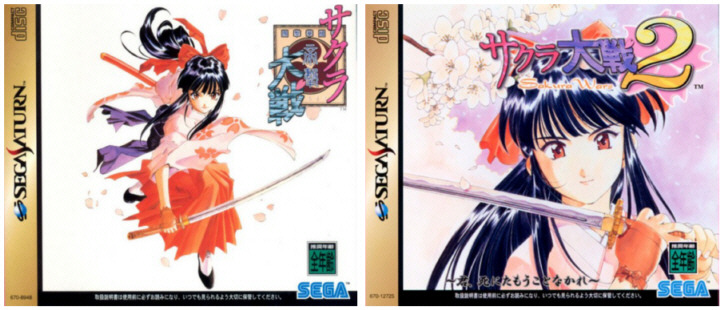
Sakura Wars (1996) and
Sakura Wars 2: Thou Shalt Not Die (1998)
How good is it? Well, the first entry in the series sold out all of its initial shipments within the first few hours of its release. Sakura Wars was the best selling SEGA Saturn game ever! As a result, it made major headlines and was covered on TV news programs. In 1997, it won the CESA Grand Prix Award and the 1997 Game of the Year Semi-Grand Prix Award as voted by the public. All four of the first four games made the Top 100 Best Games of All Time list by Famitsu magazine's readers. All of the mainline games have received universal praise by the Japanese media in game reviews, earning nearly perfect scores. Sakura Wars scored first place in Famitsu magazine's 2009 list of the most wanted video game sequels of all time. It sold mountains of merchandise from video games to comics to cartoons to apparel and household supplies to posters and wall scrolls to toys and costumes to food to carrying bags to musical albums and stage plays. At the top of the SEGA Amusement Center in Tokyo, a Sakura Wars-specific shop (and a later cafe as well) adorned the building for more than a decade. By 2010, the Sakura Wars series had sold over 4,500,000 game copies.
It's Show Time! Sakura Wars 6, Here We Go!
From the sparse official announcements about the next game, we know that the new Sakura Wars game (which this article will refer to as Sakura Wars 6) is not a spin-off, nor a side story, nor a prequel, nor a reboot, nor a re-imagining. Sakura Wars 6 will be a whole new entry in the mainline Sakura Wars series. Its story will follow that of Sakura Wars V (5), the Sakura Wars V Original Video Animation (OVA), and Dramatic Dungeon Sakura Taisen, the most recent canonical entries in the series.
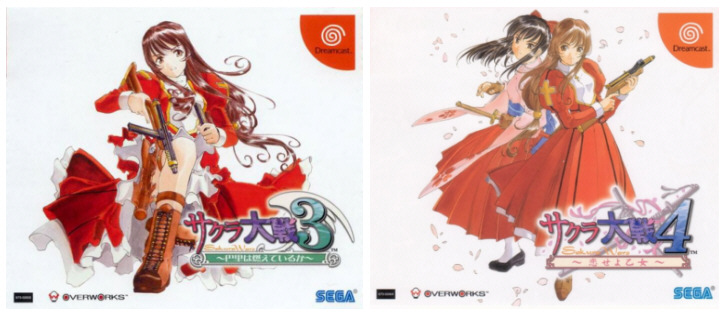
Sakura Wars 3: Is Paris
Burning? (2001) and Sakura Wars 4: Fall in Love, Maidens (2002)
The story will take place one year after the events of the Sakura Wars V game. The new game's setting is that of the Imperial Capital of Japan, Tokyo, in the year 1929. The player will assume the role of Ichiro Ohgami (sometimes spelled Oogami).
Ohgami acts as the leader or manager of the members of the Japanese division of the anti-demonic forces which protect the world from evil in Tokyo. He must earn and maintain their trust so that they can cooperate as a cohesive single troop to fulfill their missions to repel the forces of evil. (For those who have played Sakura Wars V, Ohgami's role is similar to that of his nephew, Shinjiro Taiga, but in Tokyo instead of New York.) Similar to the New York Division's mecha units called S.T.A.R.'s from SW5, the Tokyo Division's pilots' mecha are called Koubu. These mecha are powered by steam energy and enhanced by the spiritual energy of their operators.
The Platforms
Now let's talk about the platforms which are the computer operating systems (OS's) and video game consoles that are likely to be the release targets for Sakura Wars 6. If we examine the releases in the series, we can see that until the discontinuation of SEGA's own hardware platforms such as the SEGA Saturn and the Dreamcast, Sakura Wars was mostly confined to SEGA's platforms. However, this was not exclusively the case as we saw two Sakura Wars releases for the Game Boy series of hand-held game consoles. These games were Sakura Taisen GB and Sakura Taisen GB2. In addition to these, we also saw the release of ports of some Sakura Wars games for Microsoft Windows in Japan which were ported from the Saturn and Dreamcast.
After SEGA's tragic exit from the hardware industry, the Sakura Wars series, just as other SEGA series, went multi-platform. Nearly every Sakura Wars game was ported to Microsoft Windows. Meanwhile, Sakura Wars 1 was remade for the PlayStation 2, eventually followed in 2005 by Sakura Wars V for PS2. Sakura Wars 1 and 2 were also ported to the PlayStation Portable (PSP). Many years later, NIS America would hire another company to port Sakura Wars V to the Nintendo Wii when NISA was localizing Sakura Wars V for North America and Europe. Later, RED Company and SEGA would develop and publish Dramatic Dungeon Sakura Wars for Nintendo DS.
When counting all of these original releases and ports, this makes for 4 releases for Nintendo platforms, 0 releases for Microsoft Xbox platforms, 0 releases for Apple Mac / Mac OS, 0 releases for GNU Linux, and very numerous releases for the PlayStation and Windows platforms, with PlayStation 2 and Windows playing hosts to the majority of Sakura Wars releases beyond SEGA's own consoles.
Therefore, statistically speaking, it is very likely that Sakura Wars 6 will see releases on PlayStation 4 and Microsoft Windows, and it is very unlikely that Sakura Wars 6 will be released on Xbox One and Nintendo Switch. Let's presume that PS4 has a 100% chance, Windows has a 95% chance, Switch has a 15% chance, PlayStation Vita, 3DS, Mac, and Linux each have a 10% chance, and Xbox One has a 5% chance.
Xbox One is practically discontinued in Japan, and therefore, unless SEGA makes a special exception for the West, Sakura Wars 6 will probably not see an Xbox release. Linux and Mac might see a release, but only if SW6 is developed using a cross-platform game engine which supports those platforms such as Unity or Unreal, and even then it is unlikely as most SEGA-published games are not for Linux nor Mac except for a few Western-developed games such as Football Manager. If SW6 is released for PC's, then it is 100% likely that it will be released via Steam, as Valve's Steam is currently the most popular way of purchasing PC games.
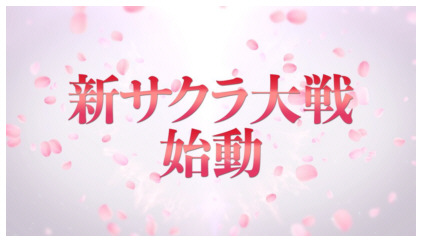
Vita is a possible target but it is also somewhat unlikely. While the Vita has greatly diminished in popularity in the West since its debut, in Japan the hand-held console has stayed strong, especially among fans of RPG's. However, the PSV is now 6 years old, and such an age for a console definitely puts it at a disadvantage. If SW6 is announced for PSV, expect the PSV release to stay limited to Asia.
Nintendo's 3DS is a possible platform, but as it is even older than the PSV, and it has already been superseded by the Nintendo Switch, it is not a likely target.
Switch is the most likely of any of the Nintendo platforms to see a release of Sakura Wars 6. However, unless RED and SEGA want a portable copy of SW6 for consoles, it does not seem a likely choice.
Android and iOS, the smart phone and tablet platforms, could see a release of Sakura Wars 6. More games are targeting these for release. However, the limitations of portable hardware might cause SW6 to not be released for these platforms, so the likelihood of this depends heavily on the development team's choice of game engine and the level of visual effects they are going for. In other words, if the games are mainly 2D with sparse 3D and are not too taxing on Graphical Processing Units (GPU's) nor battery life, then we might see SW6 for Android or iOS. The odds are about 35% for an Android release, and 40% an iOS release given the general tendency of Japanese game developers to prefer iOS over Android for deployment.
PlayStation 4, what with it being the most recent mainline PlayStation, and Microsoft Windows, what with it being the most popular home computer OS, are both more-or-less a lock for SW6. Therefore, Windows get an approximation of 95% odds (with the game working on Windows 7 or newer), and 100% odds for PlayStation 4.
The Release Date
So when will we see Sakura Wars 6 for ourselves?
Usually with Japanese companies, a game will release within several months after its initial reveal. Unlike most Western companies that announce games one year to several years in advance, Japanese companies don't usually reveal a game until they are certain they are going to release the game, and that there is less than a year to go before the expected time of release.
However, a game will not be released until about three months after its most major reveal. SW6 has not had this major reveal yet.
As of the writing of this article, the companies involved have only acknowledged the existence and development of this game, telling its fans and customers to "stay tuned" for more information in the future. Thus Sakura Wars 6 should not be expected by July 2018. It is possible that we might see the game's release in the autumn of 2018, with a projected release date in October 2018 for Japan.
It is certain that we will see and hear more about Sakura Wars 6 during the next several months. Expect major amounts of SW6 media to be shared by SEGA during the Tokyo Game Show. This year's TGS is scheduled for September 20th through September 23rd; there will doubtlessly be much to see and hear about Sakura Wars 6 there. With TGS happening in September, an October release for SW6 is a real possibility.
However, with so little known about SW6 in April 2018, it is better to plan for a release window rather than a specific month. A release from October to December is 80% likely, while a release before the end of March 2019 is 90% likely. Naturally, delays can occur; however, this seems to be a realistic time-table.
Will Sakura Wars 6 Head West?
Will we get to officially play Sakura Wars in a Western language? That's the 20 million yen question! Let's look to the past to try to divine the future.
In 2006, the company Akella localized Sakura Wars 1 and 2 for Windows into Russian for release in Russia. In 2010, NIS America localized Sakura Wars V for North America and Europe, with North America getting Japanese audio, English subtitles, and English audio for PS2; and North America and Europe getting an English translation with only English audio for Wii.
Thus, out of the entire Sakura Wars collective, "the West" has only seen three releases - Russian Sakura Wars 1, Russian Sakura Wars 2, and English Sakura Wars V. Based upon that, the odds aren't good that the West will see Sakura Wars 6 in any official capacity.
However, there is hope! With the commonness of cross-platform game engines being used in modern Western game development and these engines having plenty of good Japanese documentation too, this trend is happening more and more with Japanese-developed games as well. These engines, such as Unity, make porting to additional platforms much easier than in the past with the proprietary, platform-specific game engines like those used with Sakura Wars 2 and 3.
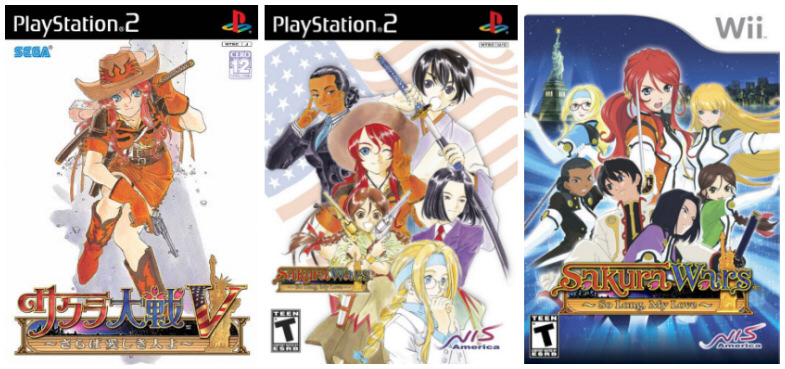
Sakura Wars V: So Long,
My Love (2005) was the first game in the series to be released in English
(2010).
Oji Hiroi, the major original creator, producer, and planner for the Sakura Wars series, has long wanted the series to break out in the West to the same degree it has broken out in Japan. This is why Sakura Wars V was set not in Japan like most of the other stories, but in America. After the terrorist attacks of 2001, Oji Hiroi was inspired by the common American people's actions in the face of tragedy and how they helped each other and rebuilt that which was destroyed. So in a one-two punch combo, he was inspired to choose New York City as the stage for Sakura Wars V, hoping to capture that spirit into a new story set in the West while at the same time making the "most American" Sakura Wars game possible to appeal to the West while still staying true to the series' roots.
Additionally, SEGA has been trying to globalize its brand and business operations. However, it is taking a "worldwide and local" approach - certain brands, like Love and Berry, stay in Japan, while other brands, like Shenmue and Sonic The Hedgehog, are released worldwide. So far, SEGA has never published a Sakura Wars game outside of Asia, but perhaps Sakura Wars 6 could be the first. SEGA will definitely make its intentions known within the next eighteen months.
So there you have it: Sakura Wars 6 is most likely to be released for PlayStation 4 and Windows 10, in late 2018 or early 2019. Look forward to it! (And start a petition if you need to.)
Visit Sean Robinson's Sakura Wars Revival
Project news site - http://www.nz17.com/sakura-wars/
|
There are so many wonderful video games that never see release outside of the region of their creation. Whether this is due to cultural differences, varying market acceptance, subject matter, timing, or just simply being passed over by the powers that be - the end result is tens of thousands of potential gamers never had the opportunity to play these now forgotten games. Few classic consoles were a bigger victim to this than the Nintendo Famicom, the platform that would be reworked into the Nintendo Entertainment System outside of Japan. This column will take a look at Famicom games that for one reason or another never left the Land of the Rising Sun.
Jumpin' Kid: Jack to Mame no Ki Monogatari (Jumpin' Kid: Jack and the Beanstalk Story) is an arcade style action platform game developed by Now Production and released by Asmik in 1990. Loosely following the classic fairy tale of a poor boy who scales a giant beanstalk, the player controls the titular Jack as he climbs in search of treasure and adventure. True to the game's title, Jack spends most of the game jumping upward as he ascends toward the sky. While Jack can jump an acceptable distance and height, his jumping movement can be increased by picking up springs that stunned or defeated enemies sometimes drop. Jumping power can be increased twice and in some areas of the game this boosted vertical effort is a requirement. Jack's only means of offense is throwing beans and this too can be powered up. Bean power ups are dropped by defeated or stunned enemies, same as springs, and can be increased up to three times. Most enemies can only be briefly stunned with a bean, similar to how candy stuns enemies in Capcom's Little Nemo The Dream Master, released around the same time. Only larger enemies, bosses, and specific smaller enemies can be defeated with beans and a powered up shot allows Jack to finish them off with fewer hits.

Jack encounters a large
frog guarding an entrance (left), jumping from cloud to cloud (center),
the beanstalk's design changes (right)
While Jack has a rather large health meter, looking like something more out of a Mega Man game than a platformer clearly following the Super Mario Bros. template, any contact with an enemy or hazard will cause Jack to power down. This results in a constant cycle of powering up, colliding with an enemy and subsequently powering down, then stunning another enemy to gain a power increase once again. Thankfully the few areas where increased jumping power is required feature a stream of enemies that drop the spring powerup upon being stunned. These areas are very few as the majority of the game can be traversed with Jack's basic abilities but being powered up sure does make things easier.
Jumpin' Kid mixes things up by featuring levels that go beyond simply scrolling upward along the beanstalk. Jack begins on the ground en route to the beanstalk's base. Before even beginning his climb, he is presented with a bonus stage similar to the classic arcade game Pooyan where additional points can be earned. A status and map screen shows the current route ahead as well as current and high score, current powerup levels, and the point value of bonus items. The status screens are very similar to what is seen in arcade games like Road Fighter and Ghosts ‘n Goblins or the Famicom version of Contra and lend themselves to something seen in mid 80's arcade games. Once the vertical climb up the beanstalk begins it may seem like Jack's adventure will settle into a more standard format but this is not the case. While the majority of the rest of the adventure will be moving upward, the beanstalk's appearance changes level to level, with horizontal stages in between, as well as more bonus stages for extra points. In addition to scrambling up stalks and vines, Jack will dash across the clouds, skip across rainbows in an area right out of Taito's Rainbow Islands, and infiltrate a hostile airship right out of Super Mario Bros. 3 on his way to the giant's castle at the top of the beanstalk. Defeat the giant, claim his treasures and, as this is a Famicom adventure game, rescue a princess to win.
I really enjoy this game but there are a few issues that must be addressed. While the audio and visual presentation of Jumpin' Kid is consistent and has its own style that I like, it is also very simplistic, especially for a game released in late 1990. The pastel colors and reasonably low detail sprites make the game look like something of a few years earlier. Additionally Jack's jumping movement has a bit too much float to it, which takes some time to get a handle on. Thankfully spring pickups simply increase the range and rate of his base jumping movement, rather than rework it completely. The entire adventure is also reasonably short as an action platformer goes, although there are more than a few tricky areas that will trip up an experienced player. While Jack only has one life, the game has a stock of nine continues. In addition to the arcade style progression screens, this continue system really does make Jumpin' Kid feel as if it was originally envisioned as an arcade title, where the continues would be replaced by inserting a credit. The shorter length of the game better represents a mid 1980’s arcade title and I think Jumpin' Kid would have worked well in such a setting.
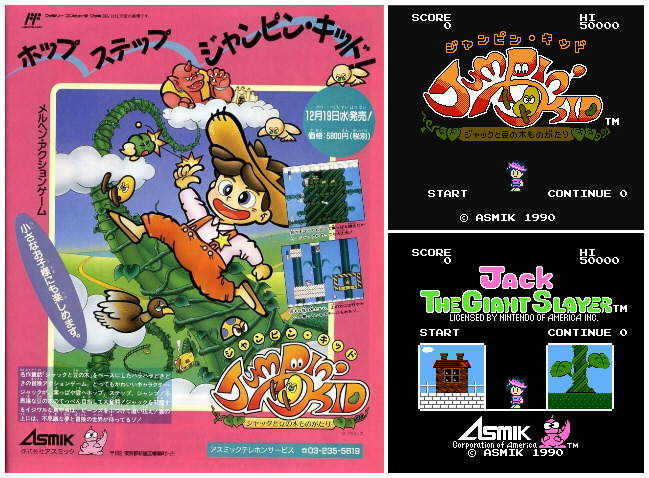
An advertisement for
the game (left), original title screen (upper right), title screen built
from unused assets in game code (lower right)
With Jumpin' Kid having the feel of an earlier era of arcade games, the question as to why it was never released on the NES seems to be easy to figure out, but Jumpin' Kid actually was planned for an NES release at one point. Not only was it announced, there are graphical assets in the game's ROM for a fully complete English title screen, re-naming the game "Jack The Giant Slayer" and displaying both a Nintendo of America licensing statement along with a revised Asmik Corporation of America logo. With an NES release this far along, why did Asmik decide to cancel it? I believe it comes back to how simple Jumpin' Kid is at its core compared to other games of the time. Other contemporary games developed by Now Production include Jackie Chan's Action Kung-Fu, Dragon Spirit: The New Legend, and Adventure Island II. Jackie Chan and Dragon Spirit both had NES releases in 1990 and Adventure Island II was out in early 1991. While none of those games are spectacular, they do demonstrate an advanced production design and refined core gameplay compared to Jumpin' Kid. Asmik Corporation of America didn't publish very many games, with Conquest of the Crystal Palace being possibly their best known NES release, itself a localization of the Famicom game Matendoji.
One could assume that the American subsidiary
of Asmik couldn't afford to have an NES game that was a total wash, and
decided it wasn't worth the expense to produce. I can't say that
I blame them, as while I really enjoy Jumpin' Kid for what it is, I can't
see it having been very well received on the NES in late 1990 / early 1991.
With all that said, if you're looking for a reasonably entertaining arcade
style diversion for a couple hours, give Jumpin' Kid a try. While
simplistic, I find it has just enough variety to warrant completion and
doesn't overstay its welcome the way a lot of simpler Famicom platformers
do.
|
Every Friday on The Retrogaming Times Facebook page (facebook.com/theretrogamingtimes), we present a Weekly Retrogaming Trivia question. This just-for-fun trivia challenge provided each week is an opportunity to test your arcane and oddball retrogaming knowledge. The answer to the question from the previous week is posted along with a new trivia question every Friday!
Below is the recap of all questions and
answers posted between this issue and the previous issue:
02/24/2018 - WEEK 55
Question: What Konami
arcade game features renditions of American folk songs "I've Been Working
on the Railroad" and "Dixie" as its intro and outro?
03/02/2018 - WEEK 56
Question: The Mario
Tennis series began on what hardware platform?
03/09/2018 - WEEK 57
Question: Outside of
Yume Kojo: Doki Doki Panic and its Super Mario Bros. 2 assorted reworks
and re-releases, what is the only other game that series antagonist Wart
has appeared in?
03/16/2018 - WEEK 58
Question: The 1972 recording
of the early synth-pop song "Popcorn" by Hot Butter is used as one of the
background songs in what Data East arcade game?
03/23/2018 - WEEK 59
Question: Of the three
licensed NES games that Tengen first released, what was the only title
that wasn't a re-release of a Famicom game?
03/30/2018 - WEEK 60
Question: What was Tengen's
internal code name for their clone of the NES security lockout chip which
ran the 10NES program code?
04/06/2018 - WEEK 61
Question: What was the
only Game & Watch game released on the Nintendo e-Reader accessory
for Game Boy Advance?
04/13/2018 - WEEK 62
Question: In Buckner
& Garcia's 1982 song "Do the Donkey Kong" an item from the game is
misidentified, what is this item?
04/20/2018 - WEEK 63
Question: A Japan-exclusive
PlayStation release, Namco Museum Encore featured what seven arcade games?
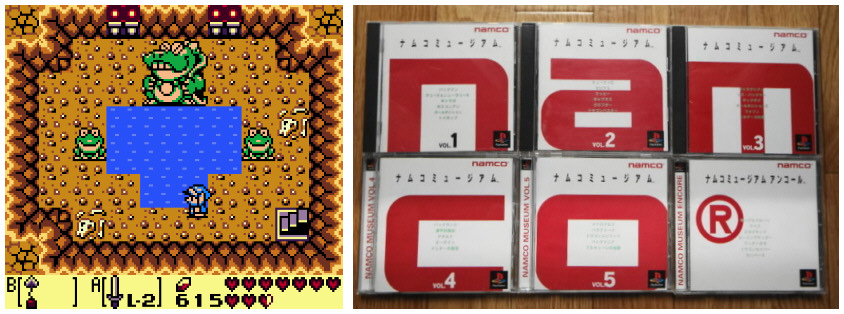
A familiar face in Link's
Awakening (left), Namco Museum concluded with Namco Museum Encore in Japan
(right)
Answers:
Week 55 Answer: Loco-Motion, known
as Guttang Gottong in Japan (1982).
Week 56 Answer: Nintendo Virtual
Boy, with Mario's Tennis in 1995.
Week 57 Answer: The Legend of Zelda:
Link's Awakening.
Week 58 Answer: Disco No. 1 (1982).
Week 59 Answer: Gauntlet.
Week 60 Answer: The "Rabbit" chip.
Week 61 Answer: Manhole, as Manhole-e.
While there were plans to release a series of Game & Watch e-Reader
cards, they never materialized.
Week 62 Answer: The song line, "Open
the umbrella up and answer the phone" incorrectly identifies Pauline's
purse as a phone.
Week 63 Answer: King & Balloon,
Motos, Sky Kid, Rolling Thunder, Wonder Momo, Rompers, and Dragon Saber.
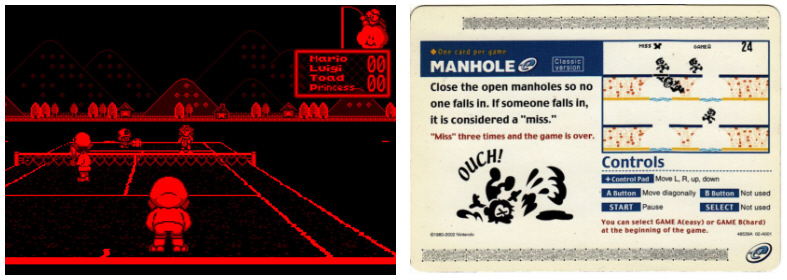
Mario's Tennis is first
served up on Virtual Boy (left), Manhole-e was unfortunately the only Game
& Watch e-Reader card (right)
Don't be left out! Be sure to follow The Retrogaming Times on Facebook for a new retrogaming trivia question every Friday!
We need your questions! If
you have a trivia question you would like to submit for possible inclusion
in the Weekly Retrogaming Trivia question pool, e-mail it to trt@classicplastic.net!
If you question is selected to be featured, you will be entered in our
year-end prize drawing!
|
Just a couple weeks ago I noticed a few bright lines creeping up the bottom of my 32" Toshiba CRT television. A moment later the picture began to shake a little, obviously a sign that the vertical hold adjustment was having an issue. While that generally isn't a very complex thing to readjust or repair, the TV had been developing issues over the past year or so. The picture had gotten soft around the corners and blues had begun a tendency to oversaturate. Additionally about two months prior, the TV would occasionally make a clicking sound when first turned on, usually a sign the flyback transformer is going bad. With all the issues that had begun to stack up against one another, I decided it was finally time to dispose of my massive CRT TV after about nineteen years of service.
While a lot of people keep a CRT around for retrogaming, this was my main TV for everything as I absolutely loved the performance it gave until near the end. After hauling the behemoth downstairs for disposal it was time for a replacement. Alas the massive space where the old TV once sat is now occupied by a modern flat LED TV. While the built-in upscaler for standard composite input isn't that bad, I have a low-cost Lenkeng upscaler on the way. I just can't see dropping the crazy money on a top of the line Framemeister upscaler as it contains a lot of features I wouldn't use. I also always see an awful lot of non-working ones out in the mix for something that costs so much money with no real warranty. Either way, with the lower profile TV I was able to move some of my devices around and now have space for a medium size CRT in addition. I really enjoy lightgun games so I'm glad I was able to make the space for another (smaller) CRT when I come across one.
Now if all this happened a few months earlier I would probably head out to a local Silicon Valley institution, WeirdStuff Warehouse, and get a nice salvage CRT TV for a few dollars. The thing is, WeirdStuff Warehouse closed its doors at the beginning of April. WeirdStuff was one of the last great as-is salvage places in Silicon Valley, a huge warehouse of electronics scrap with an ever-changing inventory. The closure was due to the warehouse space on the edge of Moffett Federal Airfield (right down the road from Atari's former headquarters) being acquired by Google, and it was time for them to take possession. Due to the always increasing property costs in the valley, WeirdStuff was without another location to move their massive inventory to and had to shut down. Over the years I've purchased countless components from there for use in repairs, video game controllers, cables, laptop computers, monitors (where else am I going to find 4:3 panel monitors for $15, guaranteed), and seen all kinds of cool things that I just missed out on - the most recent being a Fairchild Channel F. The night after they closed down I took a ride by to pay final respects, yet another part of Silicon Valley that is sadly vanishing.
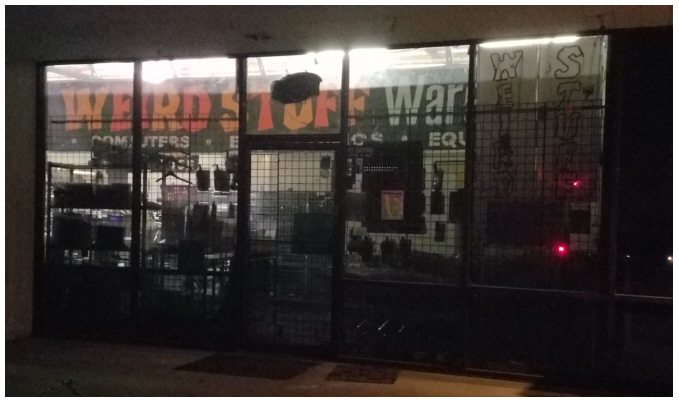
WeirdStuff Warehouse
on the night of April 9th, 2018.
Thank you once again for reading The Retrogaming Times. We'll be back on July 1st with our next issue. Be sure to follow The Retrogaming Times on Facebook and join our community for the latest updates and information! I sincerely hope you enjoyed this issue and that you will return to read the next issue and possibly submit an article yourself. Remember, this newsletter can only exist with your help. Simply send your articles directly to me at trt@classicplastic.net or check out the submission guidelines on the main page. Submit an article today and join a great retrogaming tradition!
See You Next Game!

Content and opinions on this
page are those of their respective writer(s)
Assembled and published
by David Lundin, Jr. on May 1st, 2018 at ClassicPlastic.net
© 2018 The Retrogaming
Times. All Related Copyrights and Trademarks Are Acknowledged.